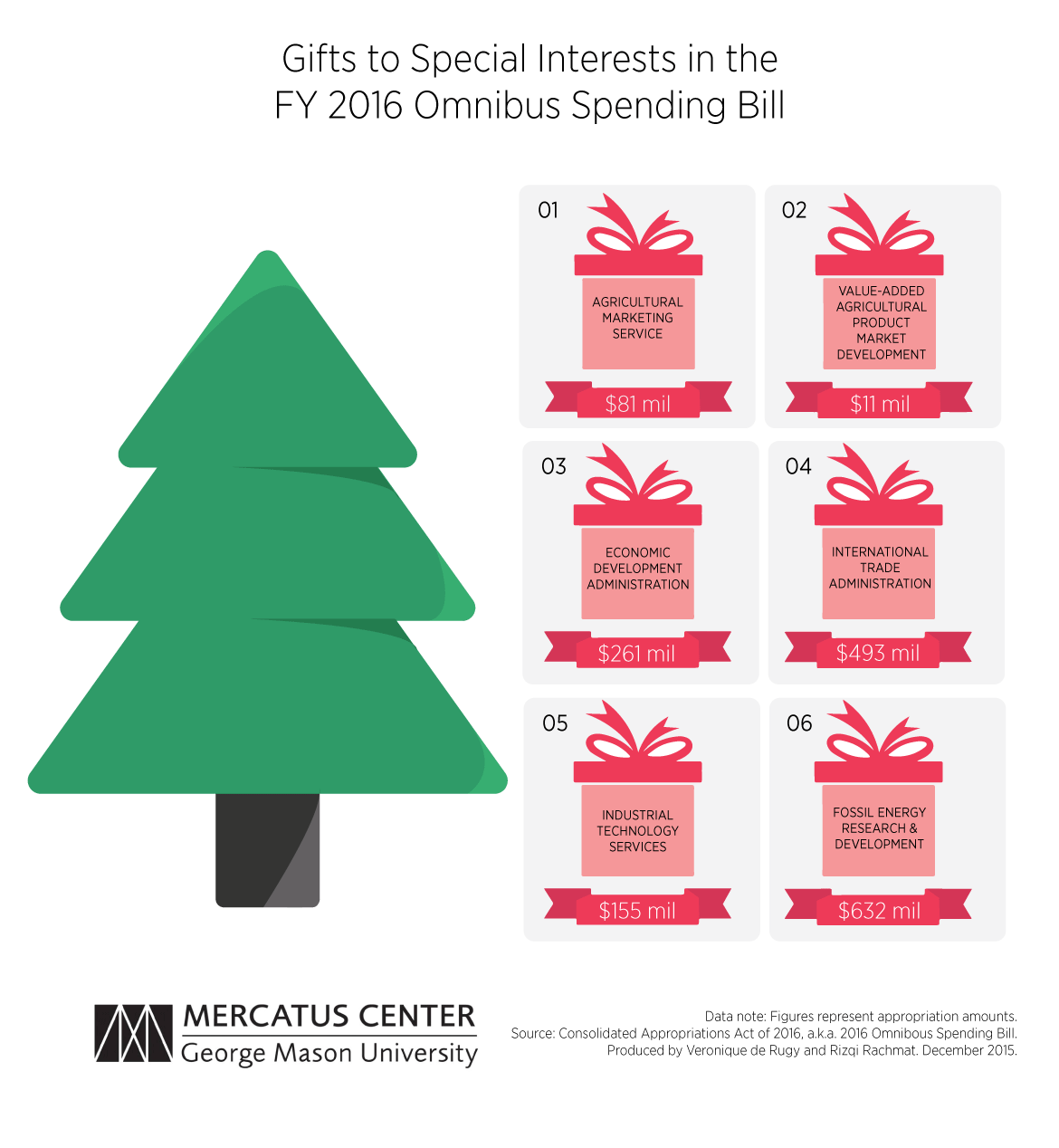- | Government Spending Government Spending
- | Data Visualizations Data Visualizations
- |
Omnibus Spending Bill Is a Christmas Gift to Special Interests
The spending bill, which is more than 2,000 pages long, contains funding for numerous programs that largely benefit particular interest groups at the expense of taxpayers and the broader economy. This week’s holiday-themed graphic singles out 12 examples, but it by no means represents all of the gifts for special interests contained in the bill. Although the individual sums are not large relative to the overall spending contained in the bill, the examples highlight the problem with a federal government that faces few limits on how it can spend taxpayer money.

In time for the holiday season, Congress just passed a $1.1 trillion omnibus spending bill that amounts to a massive sack of Christmas gifts for a multitude of special interests. The presents were made possible by the business-as-usual budget framework agreement that policymakers struck in October, which I previously discussed.
The spending bill, which is more than 2,000 pages long, contains funding for numerous programs that largely benefit particular interest groups at the expense of taxpayers and the broader economy. This week’s holiday-themed graphic singles out 12 examples, but it by no means represents all of the gifts for special interests contained in the bill. Although the individual sums are not large relative to the overall spending contained in the bill, the examples highlight the problem with a federal government that faces few limits on how it can spend taxpayer money. 
 1. Agricultural Marketing Service
1. Agricultural Marketing Service
The US Department of Agriculture’s (USDA) Agricultural Marketing Service received $81 million to provide marketing services to producers of certain agricultural commodities. The benefits include a news service and support in promoting their products. Those responsibilities should be completely financed and administered by the benefiting producers—not taxpayers.
2. Value-Added Agricultural Product Market Development
Although the price tag is relatively small, the $11 million in the budget for another marketing program benefitting agricultural interests is an example of the duplication that comes with an overgrown federal government. This grant program is part of the USDA’s Rural Business-Cooperative Service and as the government website explicitly states, its goals include “increasing producer income.”
3. Economic Development Administration
A relic of Lyndon Johnson’s Great Society programs, the Department of Commerce’s Economic Development Administration received $261 million to fund and administer programs that directly and indirectly benefit commercial interests. The agency has survived several attempts to abolish it over the years, and its continued existence is a testament to how difficult it is to get rid of a government program once it has been created.
4. International Trade Administration
International trade is critical to the nation’s economic well-being, but it is not the federal government’s role to directly support commercial interests through export promotion. Worse, the Department of Commerce’s International Trade Administration (ITA) administers protectionist antidumping and countervailing duty laws, which harm consumers and the broader economy by restricting imports. The ITA received $493 million to carry out these activities.
5. Industrial Technology Services
The bill includes $155 million for Industrial Technology Services at the Department of Commerce, of which $133 million goes to the Hollings Manufacturing Extension Partnership (MEP). MEP exists to help small and medium-sized manufacturing companies “increase profits.” Policymakers should help these businesses through tax and regulatory reform—not through subsidies.
6. Fossil Energy Research and Development
Industries that produce fossil fuels should be responsible for financing their own research and development. The bill, however, gives the Department of Energy $632 million to assist with the research and development of things like so-called “clean coal,” which has long drawn the ire of both taxpayer and environmental groups.
7. Energy Efficiency and Renewable Energy
The federal government should not subsidize energy technologies regardless of whether they are traditional fossil fuels or new “green” alternatives. The bill provides $2 billion for alternative energy subsidies despite the government’s poor track record, including political corruption and wasted taxpayer money.
8. Extra F-35 Joint Strike Fighter Jets
According to Congressional Quarterly (paywall-restricted) the bill spends $1.3 billion on eleven F-35 Joint Strike Fighter jets that the Pentagon didn’t request. That’s good for the planes’ manufacturers, but it’s an added insult to taxpayers who have already been forced to cover cost overruns and problems with the fighter jet’s development.
9. Foreign Military Financing
The State Department’s Foreign Military Financing program received $4.7 billion to help foreign governments purchase American-made weapons and defense equipment. The propriety of the US government facilitating weapons sales to foreign countries is its own topic, but the bottom line is that taxpayers should not have to directly subsidize those purchases.
10. Senator Cochran’s Unwanted Coast Guard Cutter
Veteran appropriator Senator Thad Cochran (R-MS) secured $640 million to build a US Coast Guard ship in his state that the Coast Guard did not want.
11. Essential Air Service and Payments to Carriers
The Department of Transportation’s Essential Air Service received $175 million to subsidize uneconomical flights to rural airports. The money will be used to subsidize flights with few passengers to destinations that could be more cheaply and quickly reached by car.
12. Export-Import Bank
Last, but certainly not least, is $106 million in the omnibus spending bill for the Export-Import Bank of the United States to carry out export-subsidy programs that largely support major corporations like Boeing. The Bank was temporarily closed earlier this year but was eventually revived after policymakers caved to the well-heeled special interests who enjoy the agency’s largesse. A compilation of my research on Ex-Im can be viewed here.

